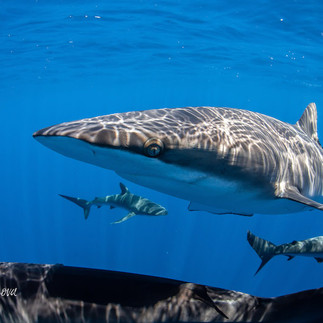The Fight for Our Oceans: Progress, Challenges, and the Future of Shark Conservation
- Sabina Scandolari

- Mar 24
- 3 min read
In 2025, the world is racing against time to protect its oceans. The "30 by 30" initiative—an ambitious global effort to protect 30% of the planet’s oceans by 2030—has gained momentum, but the fight is far from over. At the heart of this movement lies a silent guardian of marine ecosystems: the shark. Despite being feared by many, sharks are vital to ocean health, and their decline threatens the delicate balance of marine life.
This year, significant strides have been made in ocean conservation, from the establishment of new Marine Protected Areas (MPAs) to groundbreaking policies aimed at safeguarding sharks. Mexico, a nation with some of the richest marine biodiversity on the planet, is playing a critical role in these efforts. But are we doing enough?
The Shark Crisis: Why It Matters
For centuries, sharks have patrolled the oceans, keeping marine populations in check. They prevent the overpopulation of certain species, which, if left unchecked, can devastate ecosystems. However, overfishing, habitat destruction, and climate change have pushed many shark species to the brink of extinction. Studies show that shark populations have plummeted by more than 70% in the last 50 years due to human activities.
In response, countries around the world have been ramping up conservation efforts.
The 30 by 30 Initiative: Are We on Track?
The 30 by 30 initiative, launched as part of global biodiversity goals, aims to designate 30% of the world’s oceans as MPAs by 2030. This year, multiple new MPAs have been declared, bringing us closer to that goal.
One of the most notable new MPAs in 2025 is Bajos del Norte National Park in the Gulf of Mexico. Covering over 13,000 square kilometers, of that 1/4 is fully protected. This area is home to vital coral reefs and numerous marine species, including sharks. By restricting fishing and other human activities in the park, conservationists hope to create a safe haven where marine life can thrive.
However, despite this progress, challenges remain. Reports show that nearly half of Mexico’s federally protected areas lack proper management plans, making enforcement difficult. Without adequate funding and monitoring, some of these MPAs exist only on paper, failing to provide the level of protection necessary to make a real impact.
Mexico’s Role in Ocean Conservation
Mexico has long been a key player in ocean conservation, given its vast coastlines and rich marine ecosystems. he Dos Mares Reserve is an ambitious project aiming to significantly enhance marine conservation in Mexico. By establishing this reserve, Mexico’s marine protected areas would expand from 5% to 12% of its Exclusive Economic Zone, marking a substantial commitment to preserving marine biodiversity.
Spanning approximately 192,000 square kilometers, the proposed reserve encompasses waters off the coast of Baja California Sur, extending 50 miles offshore into both the Pacific Ocean and the southern Gulf of California. This region is renowned for its rich biodiversity, serving as critical habitat for endangered and migratory species such as scalloped hammerhead sharks, whale sharks, giant manta rays, and various whale species.
However, the proposal also faces challenges and threats. Some coastal fishing communities have expressed concerns about potential restrictions on traditional fishing practices, fearing that the reserve could impose additional limitations on their livelihoods. "65% of all Mexico’s fishing activities take place in the Dos mares region" -Mario Gomez (Beta Diversidad).
Moreover, the reserve aims to address threats from industrial fishing, deep-sea mining, and unregulated tourism, all of which have historically contributed to the depletion of marine resources and environmental degradation in the region.
The success of the Dos Mares Biosphere Reserve hinges on collaborative efforts among environmental groups, local fishermen, government authorities, and other stakeholders. By fostering community engagement and addressing the concerns of local populations, the initiative seeks to balance conservation goals with the socio-economic needs of the region. If realized, this project could serve as a model for large-scale marine conservation, demonstrating how environmental preservation and economic development can coexist sustainably. If approved, this could be a major leap toward the 30 by 30 goal.

Looking Ahead towards a hopeful future
While 2025 has seen some remarkable achievements in ocean conservation, the road ahead remains uncertain. The success of the 30 by 30 initiative depends not just on declaring new MPAs but on ensuring they are effectively managed and enforced. Additionally, global efforts to protect sharks must continue to expand, with stronger international cooperation to combat illegal fishing and enforce existing regulations.
The ocean is at a crossroads. The actions taken today will determine whether future generations inherit thriving marine ecosystems or barren waters. The progress made in 2025 is promising, but there is still much work to be done. The fight for our oceans is far from over—but it is a fight worth having.










Comments